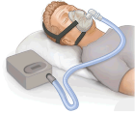What is Obstructive Sleep Apnea?
Many people suffer from a severe lack of quality sleep. Sleep disruption can come from a variety of causes. One cause of sleep disruption is a medical disorder caused by your tongue as it blocks your airway while you sleep. This type of blockage of your airway is called obstructive sleep apnea. About 6 million people in the US have been diagnosed with sleep apnea and it is estimated that 23 million people are suffering the effects of apnea without being diagnosed.
Your tongue is attached to your jaw bone mostly in the front of your mouth. When the muscles in your throat, soft palate and tongue do not work properly, you tongue drops to the back of your throat while you sleep. If the tongue causes a partial blockage, the vibrations of the tongue tissue cause a snoring sound. If the tongue blocks your airway completely, you cannot breath and your body reflexes cause you to grind your teeth, partially wake up, move, kick, and gasp for air.
Who is Affected?
Anyone of any age can have sleep apnea. Traditionally we have thought of overweight men to be at higher risk, but we now know that young children, women, teens, and even physically fit people have have sleep apnea.
Treatment options for Obstructive Sleep Apnea
C-PAP/A-PAP: is a medical device prescribed by a physician that hooks up to your nose and mouth and blows air. The air pressure pushes the tongue and other tissues out of your airway so that you can breath. This is a very common treatment for OSA, however many people find they cannot tolerate the machine and the side effects from use
Oral Sleep Appliance: is an dental device that hooks onto your upper and lower teeth while you sleep. The device is specially fitted to you so that it comfortably prevents the lower jaw from slipping back. The tongue is attached to the jaw and when the jaw is positioned forward, snoring and apnea are prevented. This is a more comfortable treatment for sleep apnea.
Surgeries: in some cases surgeries are used to treat obstructive sleep apnea. Many of these surgeries help correct the structural problems that lead to the sleep disordered breathing problems in the first place.
What happens if I don’t treat my OSA?
Sleep apnea has been shown to increase risk and severity of heart disease, high blood pressure, heart attacks, cardiac arrhythmias, sexual dysfunction, diabetes, stroke, and other chronic health issues. Sleep apnea results in preventing your body from reaching REM sleep which leads to daytime sleepiness, fatigue, short-term memory loss, anxiety, depression, early onset dementia, and other chronic illnesses. These physical effects double the risk of car accidents, increase risk of airplane crashes and generally make life miserable.
How can Myofunctional Therapy help?
The main purpose of myofunctional therapy is to build and improve the tone of the muscles of the tongue and the airway and help make the muscles of the mouth and face work in harmony the way nature intends them to work. While therapy cannot cure apnea alone current literature demonstrates that myofunctional therapy decreases apnea-hypopnea index by approximately 50% in adults and 62% in children. Lowest oxygen saturations, snoring, and sleepiness outcomes improve in adults. Myofunctional therapy could serve as an adjunct to other obstructive sleep apnea treatments. Studies have shown and our own experiences have found that some people realize a complete resolution of OSA, most patients find an improvement in their restful sleep, as with all therapy it is possible that you may not experience any improvement at all.
If you already have moderate to severe sleep apnea the most effective use of myofunctional therapy is in conjunction with a medically prescribed C-PAP or mandibular advancement dental appliance or as part of treatment plan from an orthodontist or oral maxillofacial surgeon that includes expansion of the roof of the mouth and airway. Many of my patients have found that using myofunctional therapy helps them to adjust to having a C-PAP mask on their face or a dental appliance in their mouth. When physicians or dentists recommend surgeries to correct structural problems resulting in sleep apnea, myofunctional therapy before and after surgery helps patients realize the greatest benefits from their surgeries.
Myofunctional Therapy in children
Oral Myofunctional Therapy is beneficial for adults and children that have already been diagnosed with sleep apnea or snore. The greatest benefit of myofunctional therapy is in children who are first showing signs of obstructed breathing while sleeping. During the formative years, myofunctional therapy has been shown to help guide palatal and facial development to possibly prevent disordered breathing in adulthood. This is especially beneficial if used in conjunction with orthodontics. If you are growing a human in your home and you see signs that they may have myofunctional disorders, please reach out to me for a telephone discussion or a complete evaluation. Some of the signs and symptoms you may see of myofunctional disorders in children and adults include: mouth breathing, open lips during the day, mouth open while watching TV or playing video games, long narrow face development, open mouth chewing, low tongue posture, tongue tie, a previously treated tongue tie - especially if it was treated without therapy before and after, snoring, poor sleep, bags under their eyes, ADHD symptoms, afternoon fatigue or difficulty controlling emotions or action in the late afternoon. All of these things could be indications that something is going on with their sleep. I would love to have a conversation with you to see if we can change the direction of the growth and development of your child’s face and airway. If your child is too young for me to treat (I generally don’t see children younger than 7), I would be happy to refer you to another local myofunctional therapist through the Seattle Myo Study Club.





